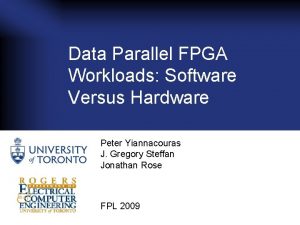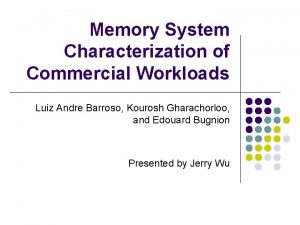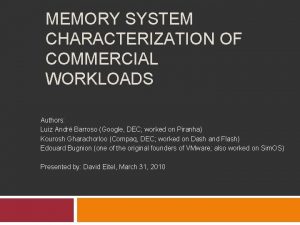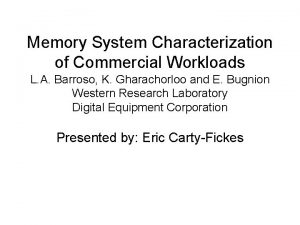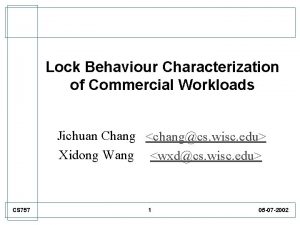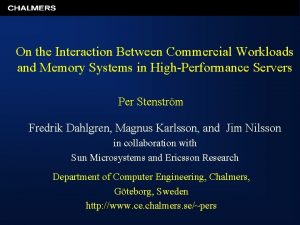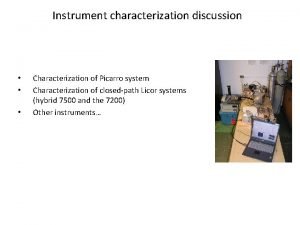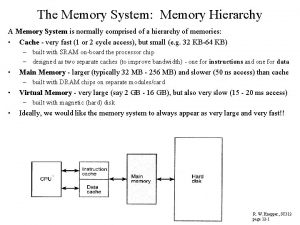Memory System Characterization of Commercial Workloads Luiz Andre









- Slides: 9

Memory System Characterization of Commercial Workloads Luiz Andre Barroso, Kourosh Gharachorloo, and Edouard Bugnion Presented by Jerry Wu

Introduction l Motivation l l Commercial workloads has become the largest market segment for multiprocessor servers Design of these systems has yet to keep up with the pace of changes in the market Lack of commercial workload performance requirements This paper presents performance studies of three classes of commercial workloads

Complications l Lack of availability and restrictions l l Large scale l l Large hardware cost Complexity l l Lack of easy access to commercial database engines Non-trivial OS-I/O interactions, lack of source code Moving target l Commercial database engines improve at a very fast pace

Commercial Workloads l OLTP Workload l l l DSS Workload l l Modeled after the TPC-B benchmark Models a banking system Modeled after the TPC-D benchmark Simulates the decision support system for a supplier OLTP and DSS workloads run on Oracle Database Engine Web Index Search Workload l State-of-the-art search engine Alta. Vista (No Google yet)

Methodology l Monitoring l l l Simulation l l OLTP and DSS benchmarks were run on Alpha 21164 using Oracle Utilized IPROBE monitoring tool to access event counters Used an Alpha port of Sim. OS Key issues l l l Amount of physical memory required Bandwidth requirement for the I/O Total runtime

Monitoring Results l OLTP l l Importance of hits and misses to secondary caches and latency of dirty misses DSS and Alta. Vista l Hits in secondary on-chip cache is the only significant memory component

Simulation Results l l Uses an Alpha port of Sim. OS Observations on OLTP l l l Small kernel component Benefit from larger cache and higher associativity Cache and memory system stalls have large effects Idle time increases with bigger caches Higher processing rates results in less demand on I/O Small fraction of communication in Oracle due to false sharing

Cache Hierarchy Performance l l l Primary cache miss important for OLTP, but more so for DSS OLTP and DSS have very different cache performance Large on-chip cache captures most of the misses in DSS, but not in OLTP False sharing increases for increasing cache line size Replacement and instruction miss rate not visibly effected

Questions
 Big data workloads
Big data workloads Composable infrastructure definition
Composable infrastructure definition Vector processing workloads
Vector processing workloads Commercial and noncommercial food service operations
Commercial and noncommercial food service operations Direct indirect characterization
Direct indirect characterization What is direct and indirect characterization
What is direct and indirect characterization Rocky slowly got up from the mat
Rocky slowly got up from the mat Implicit memory
Implicit memory Long term memory vs short term memory
Long term memory vs short term memory Internal memory and external memory
Internal memory and external memory


